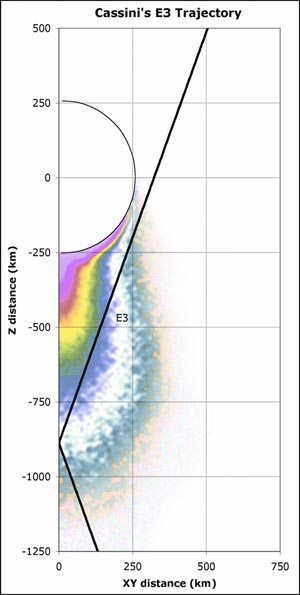 Linda Spilker, Cassini Deputy Project Scientist
Linda Spilker, Cassini Deputy Project Scientist
It’s been a whirlwind here at JPL as the data from the Enceladus flyby comes pouring in, and we scientists have been doing our thing . . . culling through it all! Sometimes there’s so much to choose from that I feel like a kid in a candy story. There is much excited email chatter among the many Cassini teams, all suggesting awesome findings. These first-looks are being matured by the team members, and we have begun to share and compare results.
You may have already seen the press release from JPL explaining that the
Cosmic Dust Analyzer (CDA) had an unfortunate software hiccup at closest approach to Enceladus and their data was not recorded. The CDA instrument measures the composition of small particles that hit the instrument, which is an important thing to do at Enceladus to understand its geyser-like jets. But like all small bumps on the road to discovery, we will find out what happened, fix it and get on with our business about the Saturn system. And what an amazing system it is.
On the very bright side, all of the other fields and particles instruments and remote sensing instruments, worked perfectly at Enceladus. They are returning fantastic data and providing an incredible look around and inside the plume, and of the surface. The fields and particles instruments are complementary to CDA and provide information on particle composition and characteristics, among other things.
As soon as possible in the week or two ahead, we will be able to announce the preliminary results to the world. Until then, I’m waiting like the rest of you are for these data sets to be analyzed, since the first-looks are looking so great! Stay tuned for some Earth-shaking — I mean moon-shaking — results!
–Linda

 Todd Barber, Cassini Lead Propulsion Engineer
Todd Barber, Cassini Lead Propulsion Engineer John Spencer, Cassini Scientist on the Composite Infrared Spectrometer (
John Spencer, Cassini Scientist on the Composite Infrared Spectrometer ( Plume particles are wonderful things to study, but it’s possible to have too much of a
Plume particles are wonderful things to study, but it’s possible to have too much of a  Todd Barber, Cassini Lead Propulsion Engineer
Todd Barber, Cassini Lead Propulsion Engineer  Todd Barber, Cassini Lead Propulsion Engineer
Todd Barber, Cassini Lead Propulsion Engineer Carolina Martinez, JPL News Team
Carolina Martinez, JPL News Team Amanda Hendrix, Cassini Scientist on the Ultraviolet Imaging Spectrograph
Amanda Hendrix, Cassini Scientist on the Ultraviolet Imaging Spectrograph  Todd Barber, Cassini Lead Propulsion Engineer
Todd Barber, Cassini Lead Propulsion Engineer John Spencer, Cassini Scientist on the Composite Infrared Spectrometer (
John Spencer, Cassini Scientist on the Composite Infrared Spectrometer (
 Todd Barber, Cassini Lead Propulsion Engineer (
Todd Barber, Cassini Lead Propulsion Engineer (